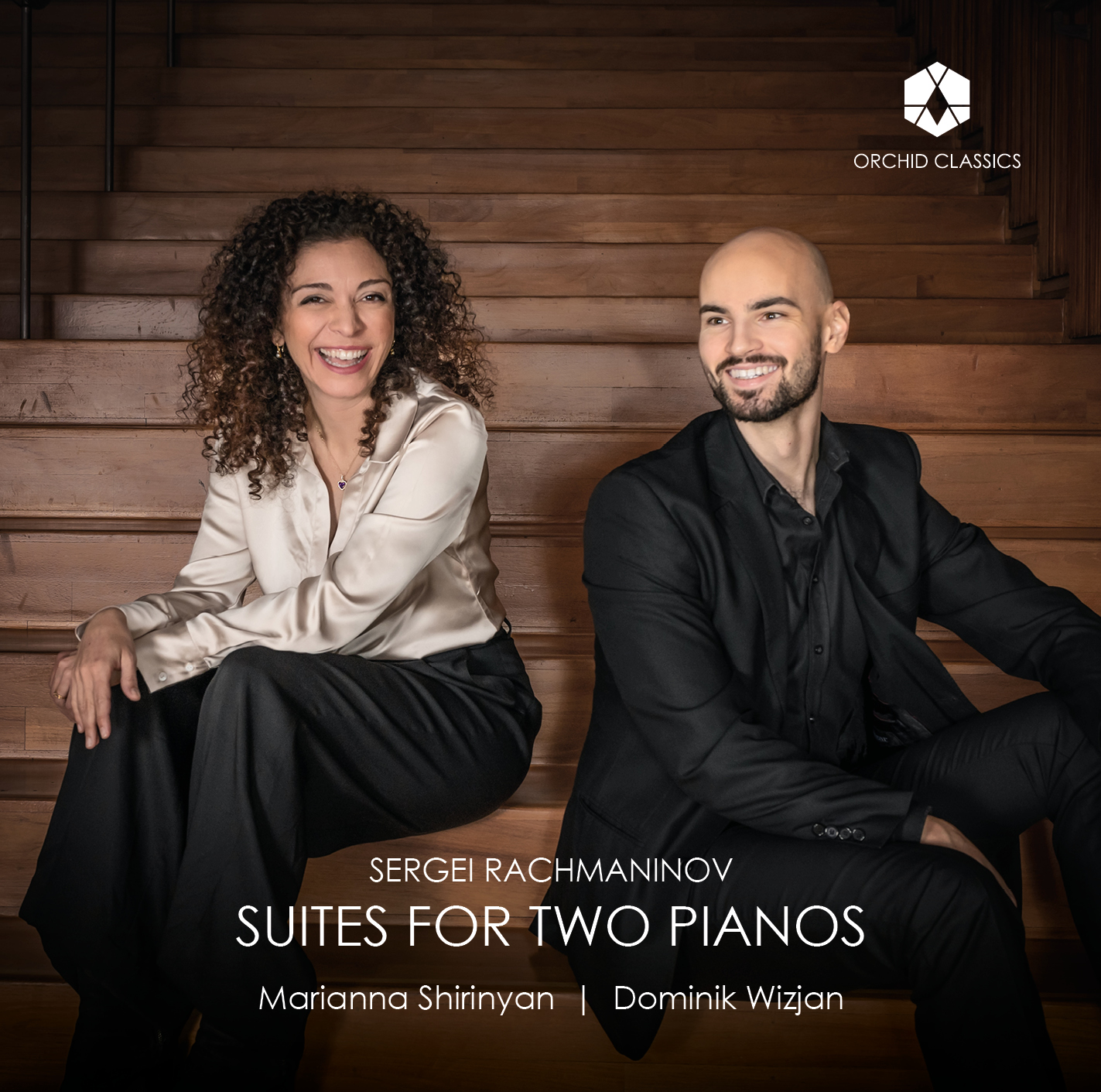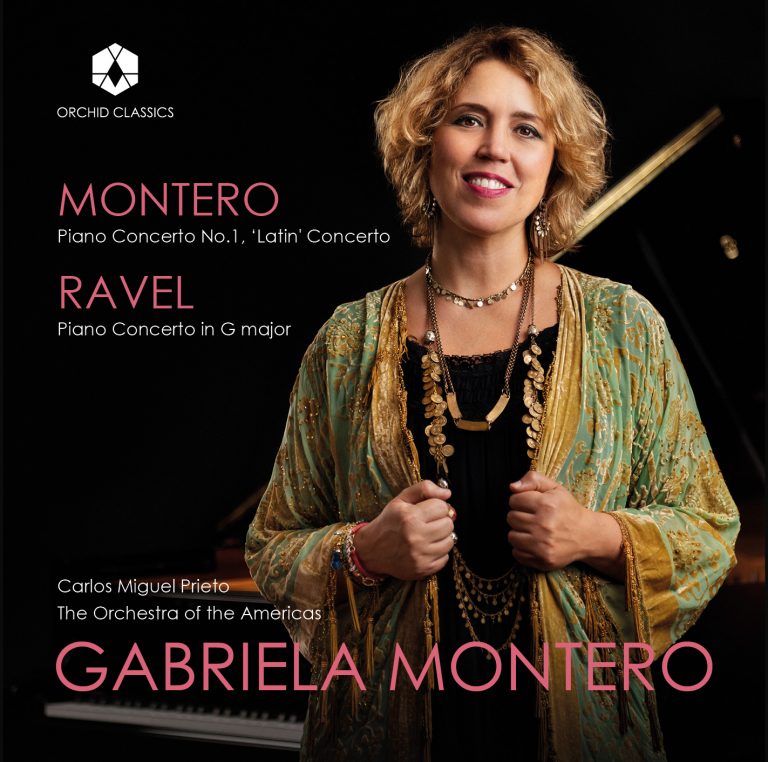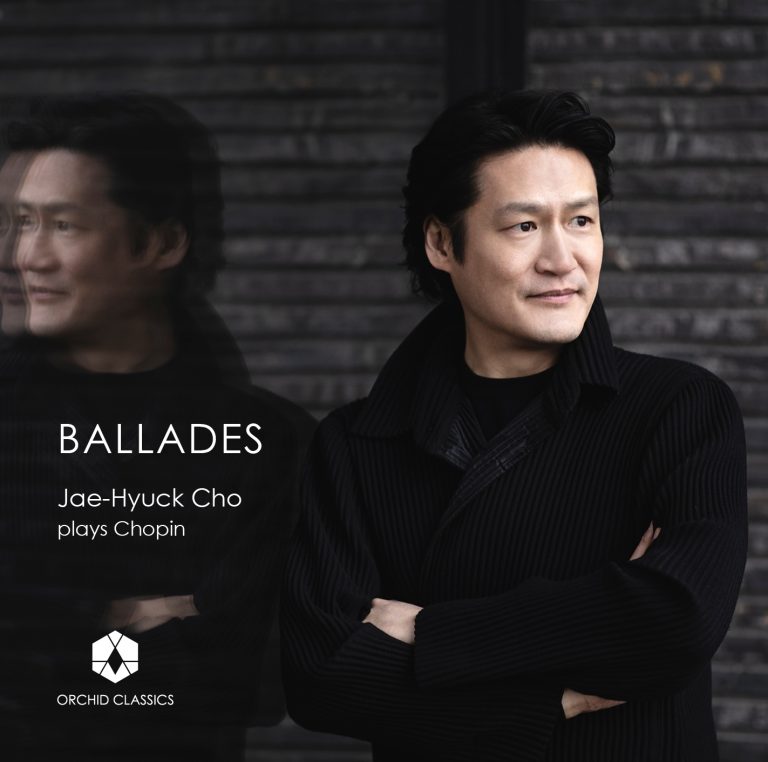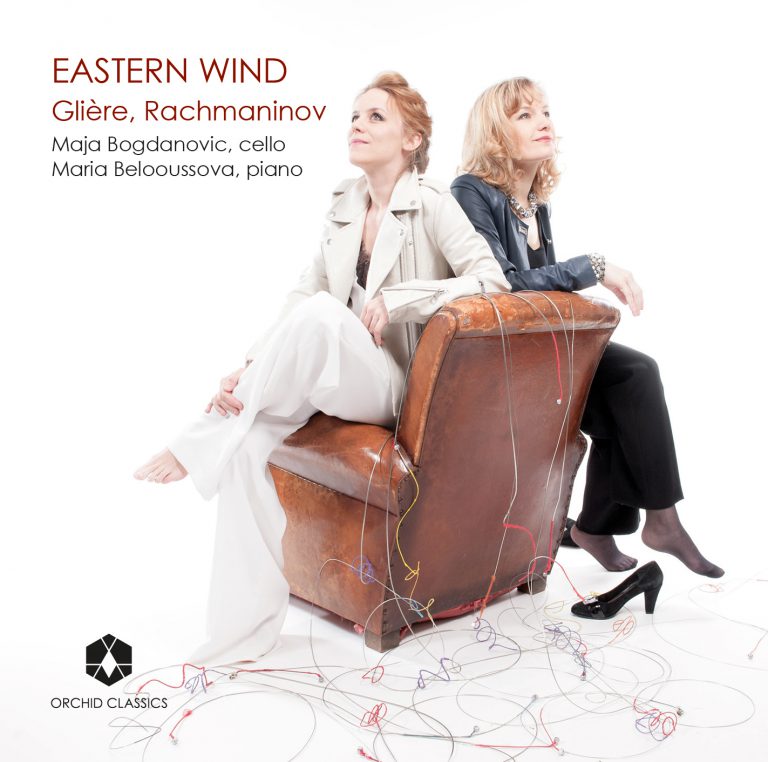Artist Led, Creatively Driven

SUITES FOR TWO PIANOS
Sergei Rachmaninov (1873-1943)
Marianna Shirinyan & Dominik Wizjan
Release Date: May 20th
ORC100191
SUITES FOR TWO PIANOS
Sergei Rachmaninov (1873-1943)
Suite No.1 for two pianos “Fantaisie-Tableaux”, Op.5
1 I Barcarolle. Allegretto
2 II La nuit… l’amour. Adagio sostenuto
3 III Les larmes. Largo di molto
4 IV Pâques. Allegro maestoso
Suite No.2 for two pianos, Op.17
5 I Introduction. Alla marcia
6 II Valse. Presto
7 III Romance. Andantino
8 IV Tarantelle. Presto
Marianna Shirinyan, piano
Dominik Wizjan, piano
Sergei Rachmaninov’s teacher at the Moscow Conservatory, Anton Arensky, initiated something of a trend for two-piano works in late nineteenth-century Russia. Arensky composed five suites for piano duo that generated considerable interest in the unusual genre and assumed the status of models. The first of them appeared in 1888, with a dedication to Sergei Taneyev and Alexander Siloti. Both pianists had taught Rachmaninov (Siloti was his cousin) and formed part of his artistic milieu.
Arensky’s second suite appeared in 1892. In the wake of its success, Rachmaninov himself – already a pianist of note – began to consider his own contribution to the piano-duo genre. In 1893, the composer wrote to his cousin Sofia Satina: ‘I am preoccupied with a fantasy for two pianos, which consists of a series of musical pictures.’ He later referred to finding inspiration in funeral bells. In October that year, Rachmaninov attended the funeral of the pianist and teacher Nicolai Zverev. On that occasion, he discussed his new two-piano work with Pyotr Ilyich Tchaikovsky.
Tchaikovsky had already noticed Rachmaninov’s talent and actively supported it, arranging for the student composer’s one-act opera Aleko to be performed at the Bolshoi Theatre. With a colleague, Pavel Pabst, Rachmaninov played his finished piano duo privately for Tchaikovsky who agreed to attend the premiere a few weeks later. The older composer died before he could deliver on his promise, and Rachmaninov saluted his senior’s support with a dedication. Pabst and Rachmaninov gave the first performance of the Suite, titled ‘Fantaisie-Tableaux’, on 30 November 1893 in Moscow.
Rachmaninov was only 20, but already his music was showing signs of the distinctive style that would come to captivate the world. The sound of Russian bells, which fills the Suite’s last movement, would infiltrate the composer’s music for the remainder of his career. Elsewhere in the score, there is plenty of the scintillating virtuosity and residual (and distinctly Russian) melancholy that would come to characterise his work. ‘I am a Russian composer,’ said Rachmaninov; ‘therefore my temperament, outlook and music are quintessentially Russian.’ Many of his melodies can be traced over the contours of Russian folk and church music.
More unusual, in the context of the composer’s piano music, was the Suite’s programmatic element. Each of its atmospheric and richly coloured movements is inspired by a poem, with excerpts printed in the original score throwing explanatory light on a world otherwise shrouded in secrecy and suggestion. We are taken through four romantically charged scenes that contextualise human feelings with imagery or sounds from nature: rippling water, tweeting birds, flowing tears – in addition to the peal of those bells (in the event, the funereal context seems to have been replaced with something more optimistic).
In 1891, Russia celebrated fifty years since the death of the poet Mikhail Lermontov. His work Venice provides the starting point for Rachmaninov’s first movement, ‘Barcarolle’, a picture of a Venetian gondola passing at dusk, perhaps as a metaphor for lost love (neither composer nor poet had been to Venice at the time their respective works were written). Woven into a glistening, rippling high-tessitura texture suggesting the pearly fluidity of the lagoon is a melody built of undulating melancholy that could have come straight from Tchaikovsky. Rachmaninov treats the two pianists as equals, their respective instruments sounding as one.
Eighteenth-century Russia took the poetry of Lord Byron to its heart, and Rachmaninov’s Moscow was not short of translations of his verse. ‘La nuit…l’amour’ is inspired by Byron’s Parisina, which suggests a nocturnal tryst blessed by a singing nightingale. The second pianist obsesses over the interval of a falling third as the music intensifies towards the emotional abandon of an erotic ‘agitato’ section before slackening again. Tears is a poem by Fyodor Tyutchev, another reflection on lost love that speaks of tears flowing ‘like torrents of rain, into an autumn night.’ Rachmaninov casts it as a slow movement, playing hypnotically with a descending four-note figure with obvious connotations. Eventually, it approximates the form of a funeral cortege.
The poet Alexei Khomyakov once wrote of the sound of church bells in Russia during Easter week as ‘engulfing the land, making the air full of vibrant, shuddering, melodious, silver thunder.’ Khomyakov’s poem Easter inspired Rachmaninov’s final movement, which lives by the resonant, bell-like percussive power of two pianos in its jubilant, stereophonic conjuring of that precise effect. Woven into this resonant rhythmic landscape is the tune of the Russian Orthodox hymn Christ is Risen. Nicolai Rimsky-Korsakov, who also used the theme in his Russian Easter Festival Overture, advised Rachmaninov to state the theme more clearly at the movement’s opening. Rachmaninov resisted.
Much water flowed under the bridge in the seven years that separate Rachmaninov’s first Suite for two pianos from his second. The composer had endured a breakdown following the critical savaging of his Symphony No.1, writing no music whatsoever before sessions with a psychotherapist in 1900 kick-started his creativity. A string of masterpieces duly followed, starting with the composer’s Piano Concerto No.2. That year, in the Mediterranean resort of Varazze near Genoa, the composer started work on his second suite for two pianos, finishing it the following year back in Russia. It was first performed in Moscow on 24 November 1901 by Rachmaninov and Siloti (two weeks earlier, the composer had given the first performance of the piano concerto with Siloti conducting).
That Rachmaninov was at the height of his powers is obvious from the Suite’s imposition and inspiration. The music also suggests that the composer had refined his approach to the duo genre, the instruments even more tightly bound together, trading material with lighting speed and stylistic panache. Gone are the first Suite’s elements of programme music while the Russianness is also played down. Rachmaninov’s themes seem more his own (with some resemblance to those of the concerto), their transformation more virile and inevitable.
The suite launches with a robust and invigorating march built initially of imposing chords which soon acquiesces to a string of echt- Rachmaninov melodies, the first emerging from the second piano while the first piano continues its rhythmic punctuation. The following ‘Valse’ is more a Mendelssohnian scherzo than a Viennese three-step, in which a cascade of notes is spiked with teasing cross-rhythms. Two trio sections introduce ripe melodies, one of them played at half speed on one piano while the other continues the waltz material at full speed. There are also hints of Rachmaninov’s favourite musical motto: the Dies Irae plainsong theme.
The lyrical ‘Romance’ has the feel of an introspective opera aria but rises to a rhapsodic climax that glances back towards the expressive world of the ‘Valse’. Rachmaninov closes with a ‘Tarantelle’, a furious Italian-style dance that the composer claimed to have based on a folk song he heard during his time in Varazze. The movement’s high passions are cast in a minor key, with shades of Liszt’s demonic Mephisto Waltz No.1. The composer makes staggering demands on their pianists, who require nimbleness, stamina and power in spades. In his old age in Beverly Hills, Rachmaninov often received visits from his neighbour, the pianist Vladimir Horowitz. In the composer’s living room, two of the greatest pianists who ever lived would reportedly play through both Suites on Rachmaninov’s two Steinways – just for kicks.
© Andrew Mellor, 2021
Marianna Shirinyan
Piano
Armenian-born pianist Marianna Shirinyan is in demand as both a soloist and chamber musician, and enjoys a reputation built on her musical sensitivity, technical brilliance and beauty of tone across a wide range of repertoire. Her love for the music she performs and her joy in sharing it with audiences are hallmarks of her performances.
Marianna has been awarded the Danish Broadcasting Corporation’s P2 Prize and the annual prize of the Danish Critic’s Circle. She is a frequent guest at a string of international music festivals and concert halls and has appeared with the Bavarian Radio, Danish National, BBC and Gothenburg Symphony Orchestras and with the Oslo Philharmonic Orchestra. She has collaborated with conductors including Lawrence Foster, Thomas Søndergård, Zoltán Kocsis, Antonello Manacorda, Eva Ollikainen, Lan Shui and Joshua Weilerstein.
From 2015 Marianna has been a professor at the Norwegian Academy of Music in Oslo and in 2021 she became a professor at the Royal Danish Academy of Music in Copenhagen. She is a Steinway Artist, Artistic Director of the Oremandsgaard Chamber Music Festival in Denmark and co-Artistic Director of Valdres Sommersymfoni in Norway.
Read more about Marianna at: mariannashirinyan.com
Dominik Wizjan
Piano
Dominik Wizjan is an outstanding pianist with a flawless and natural technique. With a refined and remarkably intelligent understanding of different musical styles, characters and expressions he makes the music dance, sing and talk with a completely natural balance between form and content.
During his studies in Szczecin, Poland, Dominik was awarded in a range of national and international competitions. At the age of 17, he made his debut with a Polish-German orchestra Pomerania under the baton of Jacek Kraszewski. After enjoying success in Poland he continued his studies under Amalie Malling at the Royal Danish Academy of Music in Copenhagen, then working with Marianna Shirinyan in both his Master’s and Advanced Postgraduate Diploma studies. He gave his graduation recital at the Academy in 2021.
Dominik has twice won First Prize in the RDAM Piano Competition in Copenhagen, and is a laureate of the International Piano Competition in San Dona di Piave (First Prize) and AIMF in Yerevan (Third Prize). He has performed throughout Europe and Scandinavia. In 2019, Dominik released his debut album under the KNS Classical label. Following the tradition deeply rooted in Polish culture, the record is devoted to etudes by Polish composers.
Read more about Dominik at: dominikwizjan.com










